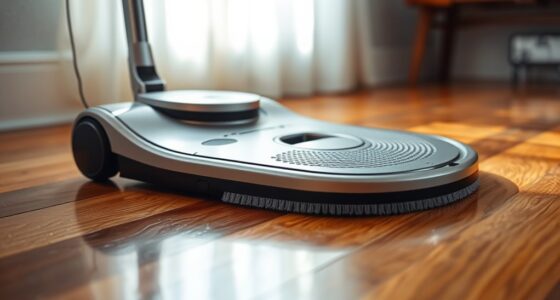Decluttering your home room-by-room is essential for enhancing your well-being and restoring order. Start by identifying sources of clutter, like emotional attachments or consumerism. Gather supplies, set a schedule, and visualize the outcome to stay motivated. Follow core decluttering principles, like the 90/90 Rule, to make decisions easier. As you tackle each room, use effective strategies to overcome challenges. Embrace the journey, and you’ll rediscover a serene living space. Keep going to explore more tips and insights!
Key Takeaways
- Start by emptying each room, assessing items based on their usage and emotional value to streamline decision-making.
- Apply the 4-Box Method (Keep, Donate, Toss, Relocate) to categorize items efficiently as you declutter each space.
- Use the 90/90 Rule to determine which items to let go of based on recent and future usage.
- Implement specific time blocks for decluttering sessions to maintain focus and prevent overwhelm.
- Establish a maintenance plan with daily tidying routines and monthly check-ins to sustain organization in your home.
The Importance of Decluttering
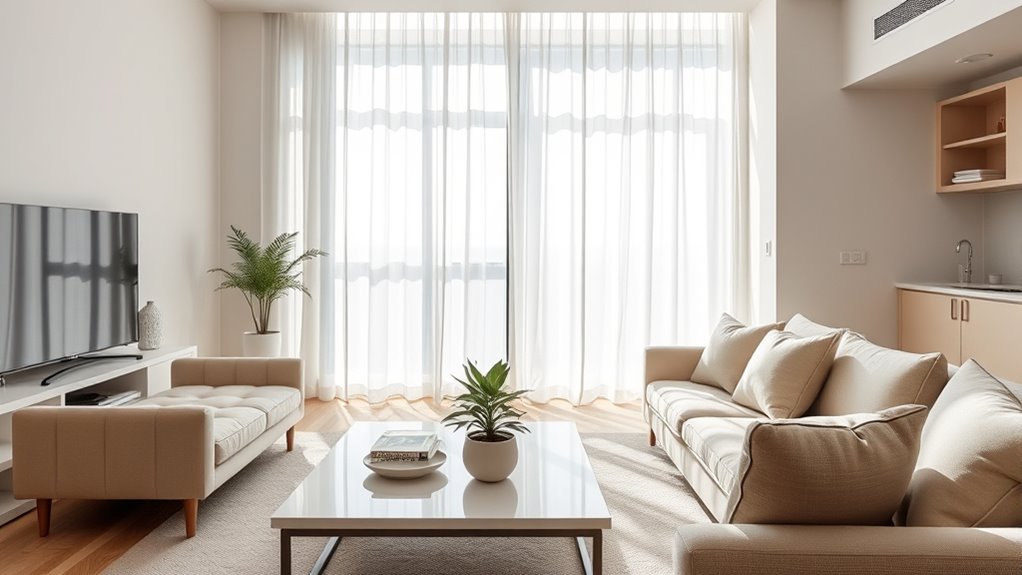
Decluttering is essential not just for a tidy space but for your overall well-being. When you embrace decluttering, you can greatly improve your mental health.
A cluttered environment often makes you feel overwhelmed, leading to anxiety and stress. By letting go of unnecessary items you don’t use, you create a peaceful sanctuary that promotes calm and control. Implementing vertical storage solutions can help free up floor space and further enhance your environment. Additionally, creating an organized space can lead to improved quality of life for the elderly, making it easier for seniors to navigate their home safely. Maintaining preventive care through an organized environment can also contribute to better health outcomes.
A cluttered space breeds anxiety; embracing simplicity fosters serenity and control in your life.
The benefits of decluttering extend beyond aesthetics; a clean space enhances focus and productivity, allowing you to streamline your daily routines. Plus, it fosters emotional well-being as you release items tied to past memories or expectations. Engaging in the art of decluttering can also facilitate better decision-making by creating mental clarity.
Ultimately, decluttering not only transforms your living space but also nurtures a happier, more content you. So why wait? Start your decluttering journey today!
Understanding the Sources of Clutter
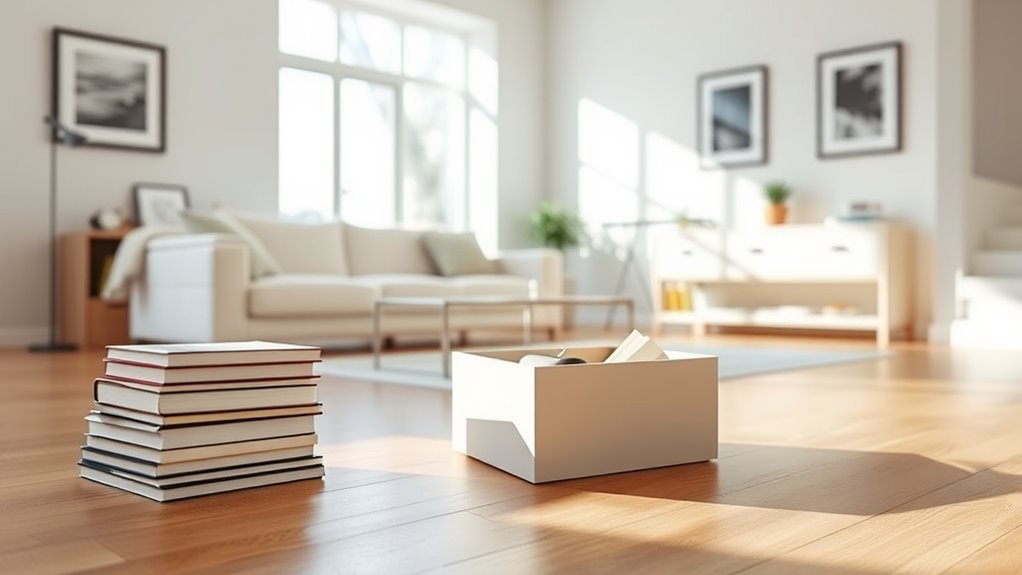
Here are some common contributors to clutter:
- Emotional attachments to gifts or keepsakes make it hard to let go.
- Consumerism encourages excessive accumulation of new items, driven by societal pressures.
- Hoarding-like behaviors may stem from mental health issues, complicating decluttering efforts. Individuals experiencing cognitive decline might struggle more with making decisions about their belongings. Seeking professional counseling can provide support in addressing these challenges. Understanding the importance of self-protection during this process can also aid in effective decision-making.
- Your living environment, especially shared spaces, can breed chaos due to differing organizational habits.
- Items often accumulate gradually, creating an overwhelming buildup that can feel insurmountable.
Recognizing these sources is the first step toward reclaiming your space and reducing clutter. Practicing self-awareness can further enhance your ability to let go of unnecessary items.
Preparing for the Decluttering Journey
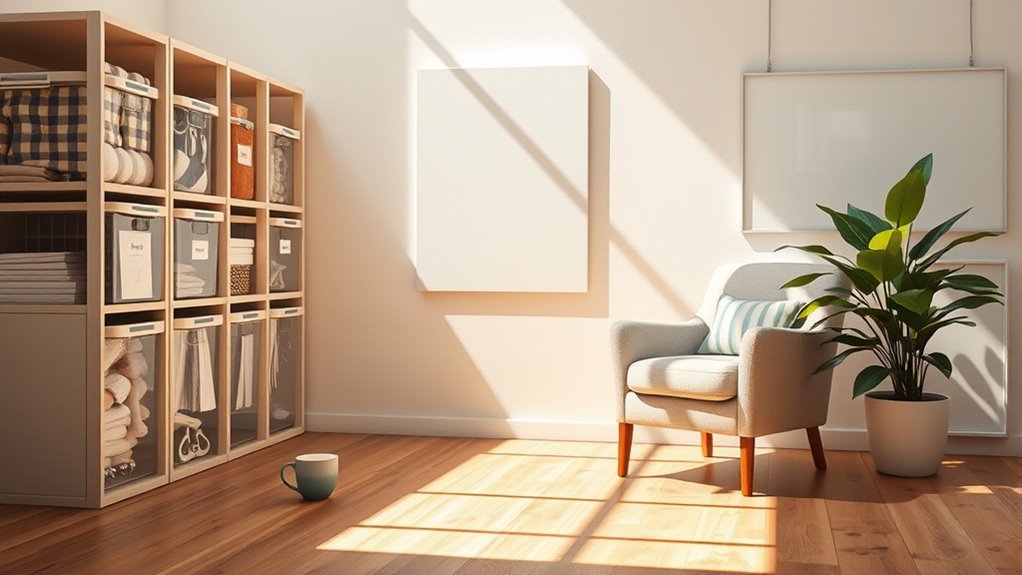
Before diving into your decluttering journey, it’s essential to prepare properly to make the process smoother and more effective.
Start by gathering important supplies like trash bags, donation boxes, and sorting containers to keep your items organized. Additionally, having a designated space for your gardening supplies can help streamline your decluttering efforts, especially if you also enjoy gardening. Incorporating healthy organizing habits can also improve your overall living environment. Regularly checking and cleaning filters in your air purifier can enhance indoor air quality as you declutter your home.
Next, create a decluttering schedule that allocates dedicated time for each space in your home, helping you avoid feelings of overwhelm.
Visualize your desired outcome—imagine the increased space and reduced stress you’ll enjoy.
Set a realistic deadline to maintain focus and accountability throughout the project.
Finally, prepare for emotional challenges by acknowledging your attachments to certain items.
Allow time for reflection, especially when dealing with sentimental belongings, to make the process easier and more meaningful. Additionally, consider utilizing unbeatable savings on storage solutions from Amazon to help organize your newly decluttered spaces.
Core Principles and Rules for Decluttering
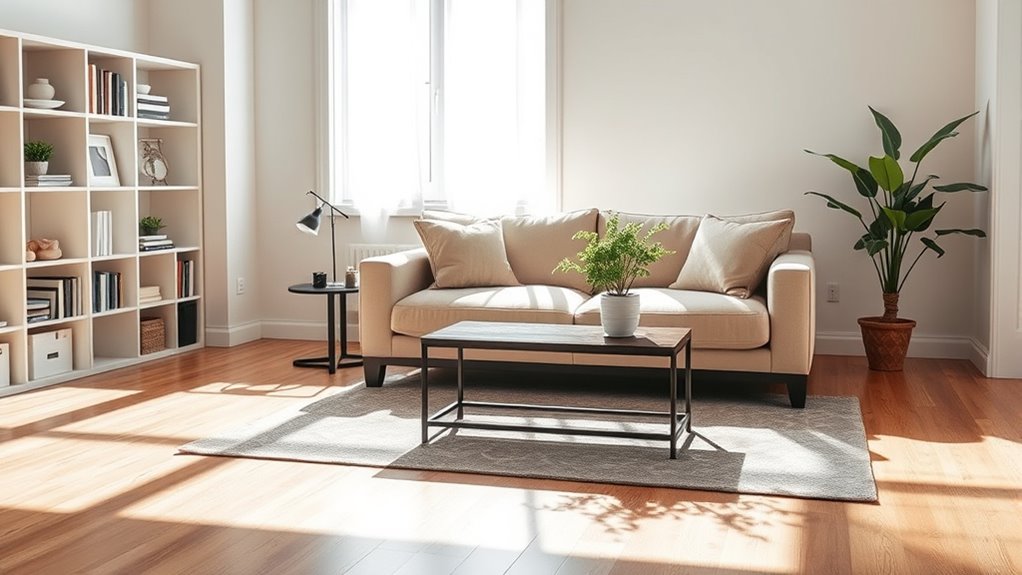
With your preparations in place, it’s time to embrace some core principles and rules that can guide you through the decluttering process.
Keeping these in mind will help you make effective decisions and manage the mental and emotional aspects of decluttering:
- 90/90 Rule: Let go of items not used in the last 90 days and not expected in the next.
- One-In-One-Out Rule: For every new item you bring in, remove one.
- Decluttering by Category: Focus on one category at a time rather than by location.
- 20/20 Rule: Discard items easily replaceable for under $20 and in 20 minutes.
- Key Questions: Consider each item’s usage, value, and space justification. Additionally, embracing a slow fashion movement can inspire you to let go of items that no longer serve you. Incorporating a best lifestyle planner can also help you track your progress and stay organized during this process. Remember, maintaining mental clarity is crucial throughout this journey to reduce feelings of overwhelm.
Additionally, maintaining a supportive community during your decluttering journey can provide motivation and accountability.
These principles will streamline your decluttering journey effectively.
Step-by-Step Guide to Decluttering Each Room

Decluttering your home can feel overwhelming, but breaking it down room by room simplifies the process.
Start with your kitchen; empty cabinets and drawers to assess frequently used items and declutter your kitchen effectively. A well-organized kitchen can enhance overall functionality and make cooking a more enjoyable experience. Additionally, ensure that any appliances you choose to keep are energy-efficient appliances to help reduce overall energy consumption. A well-designed kitchen can also elevate your home environment and increase your enjoyment of the space.
Begin your decluttering journey in the kitchen by emptying cabinets and drawers to identify essential items.
The first step in your bedroom is the “backwards hanger trick” to identify clothes you haven’t worn in six months.
In the bathroom, remove expired medications and limit personal care items to what’s actively used.
When tackling the living room, clear surfaces and categorize items, ensuring everything has a designated storage space.
Throughout, use the 4-Box Method (Keep, Donate, Toss, Relocate) to streamline decision-making and prevent feeling overwhelmed. Additionally, consider investing in a vacuum that specializes in dust removal to maintain a clean environment after decluttering.
This structured approach makes decluttering your home manageable and rewarding.
Common Challenges in Decluttering
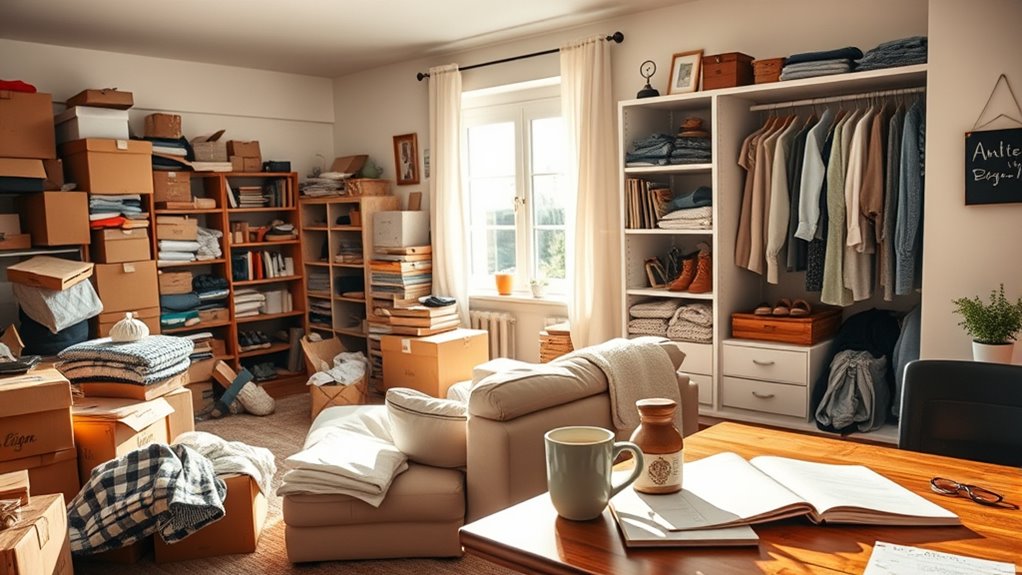
When you start decluttering, emotional attachments can make it tough to let go of items that hold special memories. Time management issues also play a big role, as busy schedules often leave little room for focused decluttering sessions. Recognizing these challenges is the first step toward overcoming them and creating a more organized space. Additionally, implementing structured routines can help facilitate a more efficient decluttering process. For example, establishing a sleep routine for your family can create dedicated time slots for decluttering, ensuring it becomes a regular part of your schedule.
Emotional Attachments to Items
Emotional attachments to items can often feel like invisible chains, binding you to possessions that no longer serve a purpose.
These connections can be overwhelming, making it difficult to let go of sentimental items. To navigate this challenge, consider the following:
- Identify items tied to significant memories.
- Reflect on the feelings these items evoke.
- Acknowledge the “sunk cost fallacy” in your decision-making.
- Focus on keeping only meaningful items that enhance your life.
- Understand that decluttering can benefit your mental health.
Time Management Issues
Time management issues can be a significant roadblock in the decluttering process, especially if you underestimate how long it truly takes. To tackle this, consider setting aside specific time blocks to declutter one area at a time.
Limiting your sessions to about three hours can enhance your focus and productivity. Creating a decluttering schedule can help keep you motivated and on track, preventing procrastination.
Be mindful of emotional attachments; using strategies like the 90/90 Rule can speed up your decision-making. Ultimately, minimize distractions from family and digital devices to create a focused environment.
With a solid plan in place, you’ll find it’s much easier to carve out the time to declutter effectively.
Developing a Maintenance Plan

To keep your home decluttered, it’s essential to develop a maintenance plan that fits seamlessly into your daily routine. By incorporating consistent daily habits, you can maintain a clean and organized environment.
Developing a seamless maintenance plan is key to sustaining a clean and organized home.
Here are some key components to include:
- Implement a reset routine to tidy high-traffic areas daily.
- Create a weekly cleaning schedule that meets your personal standards.
- Conduct monthly check-ins to evaluate your decluttering progress.
- Schedule seasonal deep cleaning, like spring cleaning, for overlooked areas.
- Set aside time annually for thorough cleaning sessions to revisit cluttered spaces.
These steps will guarantee your decluttered space remains organized and functional, making it easier to enjoy your home without the stress of clutter.
Navigating Family Dynamics During Decluttering
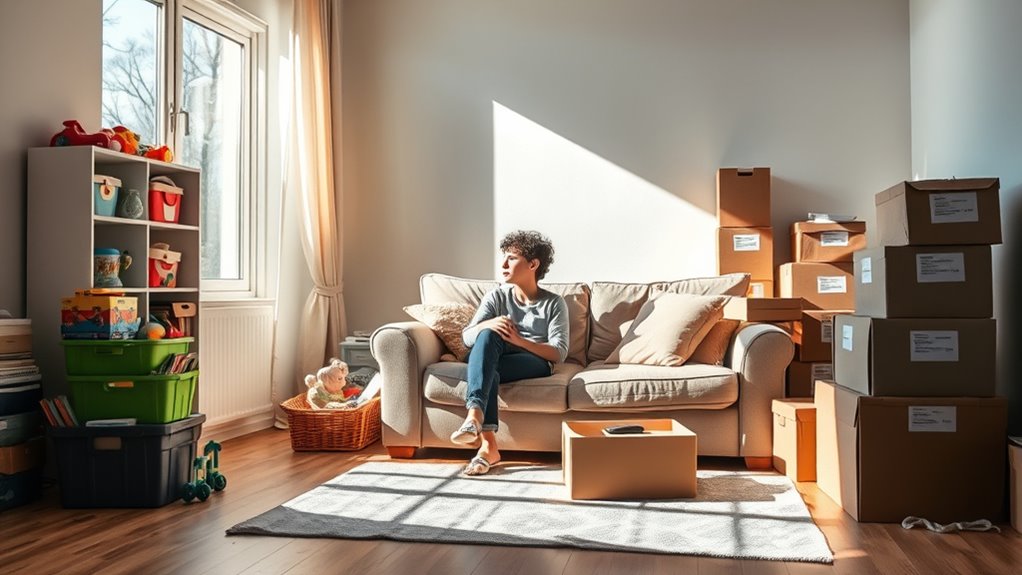
Decluttering your home can often feel like maneuvering through a minefield when family dynamics come into play. Start by initiating an open discussion with family members to highlight the benefits of a collaborative approach.
Focus on personal belongings first to inspire others and reduce resistance. For shared spaces, establish decluttering standards that respect individual preferences while ensuring overall organization.
Assign specific tasks or areas to each family member, making it a collective effort rather than a solo venture. Be mindful of emotional attachments others may have to their belongings, and encourage gradual decluttering to ease the shift.
This method fosters understanding and cooperation, creating a more harmonious environment as you tackle the clutter together.
Next Steps After Decluttering
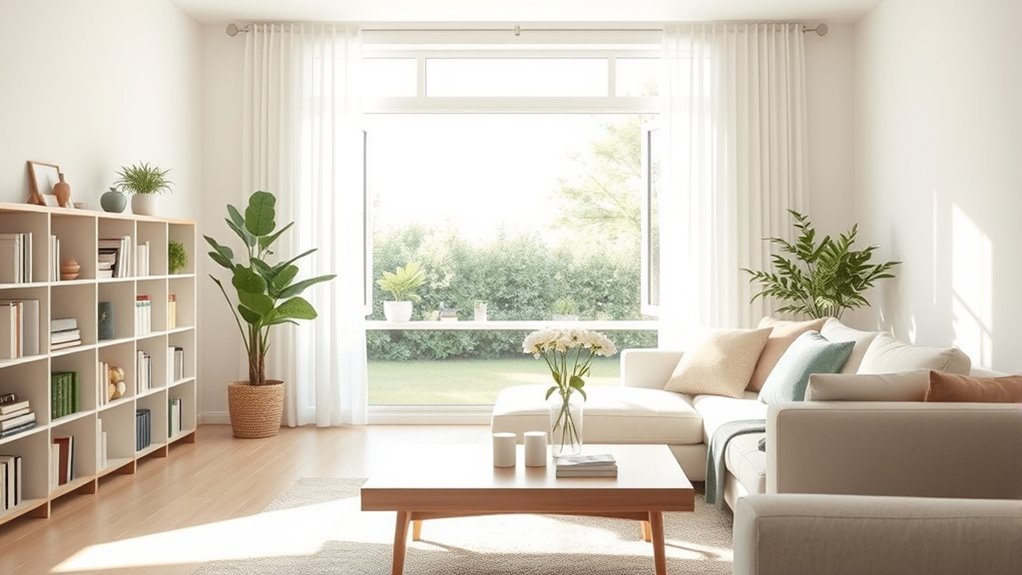
Once you’ve tackled the clutter, it’s crucial to establish a maintenance routine that keeps your space organized.
After decluttering, it’s essential to implement a maintenance routine to sustain your organized space.
Here are some next steps after decluttering to guarantee you stay on track:
- Create designated homes for all your items, making it easier to maintain order.
- Regularly assess your belongings with monthly check-ins to determine what’s still necessary.
- Adopt the One-In-One-Out Rule to prevent excess items from entering your space.
- Engage in seasonal decluttering sessions to realign your environment with your current lifestyle.
- Make daily habits a priority to prevent clutter from accumulating again.
Additional Resources for Decluttering
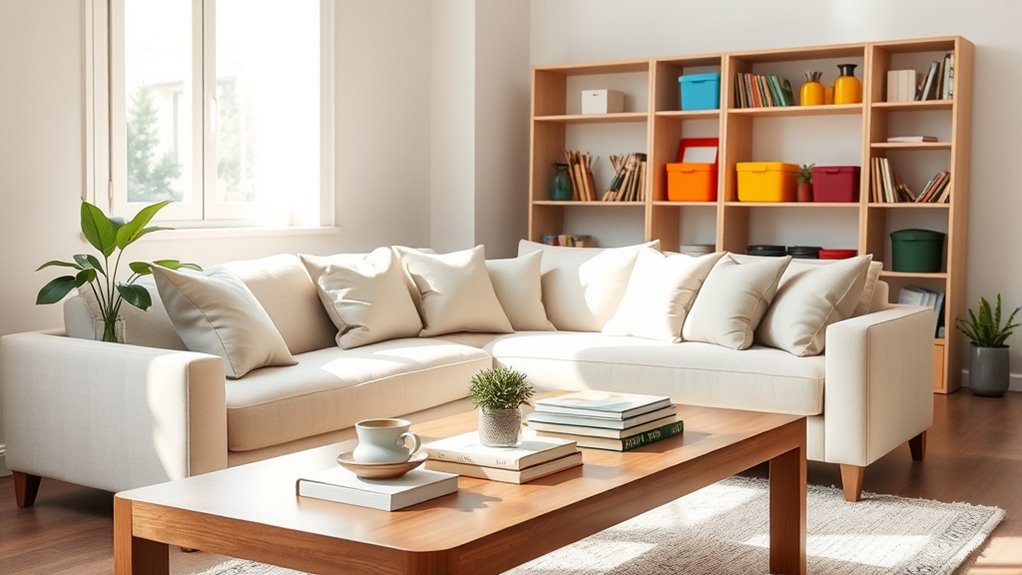
To make your decluttering journey easier, you can tap into a variety of resources.
Recommended reading materials, helpful online tools, and local donation centers can provide you with the guidance and support you need.
Let’s explore these options to enhance your decluttering efforts.
Recommended Reading Materials
If you’re looking to transform your space, diving into some insightful books can make all the difference.
These reads can guide you through the process of creating a decluttered space and help you let it go:
- “The Life-Changing Magic of Tidying Up” by Marie Kondo – Learn the KonMari Method for efficient decluttering.
- “Decluttering at the Speed of Life” by Dana K. White – Overcome emotional barriers to maintain a clutter-free home.
- “The Minimalist Home” by Joshua Becker – Discover actionable steps for simplifying your home.
- “The Joy of Less” by Francine Jay – Follow a step-by-step guide to enhance your living space.
- “Let It Go” by Peter Walsh – Embrace the psychological benefits of decluttering and having less stuff.
These resources make it easier to embrace minimalism and enjoy a happier home.
Helpful Online Tools
Several helpful online tools can make your decluttering journey smoother and more efficient. Decluttering apps like Sortly and Clutterfree help you keep track of items, making it easier to decide what to keep, donate, or discard.
Websites such as Decluttr allow you to sell unwanted electronics quickly, turning clutter into cash for your decluttered space. Consider participating in virtual workshops on platforms like Zoom for expert guidance and accountability.
Additionally, social media groups on platforms like Facebook or Reddit provide community support, inspiration, and tips from those with similar goals. Tools like Trello or Asana can help you create a decluttering timeline and to-do lists, ensuring you stay organized and focused throughout the process.
Local Donation Centers
While decluttering your home, consider the impact of donating items to local centers, as they can transform your unwanted goods into valuable resources for others.
By choosing to donate, you not only create a decluttered space for yourself but also help those in need.
Here are some items you can contribute:
- Clothing in good condition
- Household goods like small appliances
- Non-perishable food items for local shelters
- Professional attire for organizations like Dress for Success
- Furniture and larger items that can be picked up
Many local donation centers, such as Goodwill and Habitat for Humanity ReStores, offer convenient options and pick-up services, making it easy to give back while simplifying your life.
Frequently Asked Questions
What Is the 50% Rule in Decluttering?
The 50% Rule in decluttering means you should aim to reduce your belongings by at least half.
When you evaluate your items, ask yourself if you really need or use each one. This approach helps you prioritize what’s essential and eliminates excess.
By applying this rule, you’ll create a more organized space and lower the stress that comes from clutter.
It encourages a more intentional lifestyle where every item has purpose or joy.
What Is the 12 12 12 Rule for Decluttering?
Imagine you’re on a treasure hunt, but instead of gold coins, you’re searching for clutter. The 12/12/12 Rule makes this fun and manageable.
You find 12 items to toss, 12 to donate, and 12 to return to their rightful spots. This method helps you tackle clutter without feeling overwhelmed.
What Should I Remove First When Decluttering?
When you start decluttering, focus on easily identifiable items.
Begin with expired food in your kitchen or outdated medications in your bathroom to build momentum.
Tackle junk drawers next, as they usually contain miscellaneous items that can be quickly sorted.
Concentrate on visible clutter, like countertops, to create an immediate sense of order.
Finally, use the 12/12/12 rule to efficiently remove items and keep the process moving smoothly.
What Is the 5 Second Rule for Decluttering?
Ever stared at an item, wondering if it’s worth keeping? That’s where the 5 Second Rule comes in.
If you can’t remember the last time you used it within five seconds, it’s time to let it go. This quick decision-making trick helps you cut through the clutter without overthinking.
Conclusion
You’ve taken significant steps toward a clutter-free home, and now it’s time to maintain that fresh, open space. By regularly evaluating your belongings and sticking to your decluttering plan, you can prevent clutter from creeping back in. Imagine walking into your home and feeling a wave of calm wash over you—doesn’t that sound inviting? Keep the momentum going, and watch as your home transforms into a sanctuary that reflects your true self.


